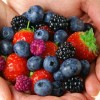 Fresh and frozen berries are popular foods. When berries are picked for fresh consumption, they are usually packed directly without washing because they are highly perishable. There is typically no “kill step” that would eliminate pathogens on fresh or frozen berries. Foodborne illness outbreaks have been associated with the consumption of fresh or frozen berries that were contaminated with pathogenic viruses, parasites, or bacteria. Contamination can occur before or during harvest or during final preparation. This 11-page fact sheet was written by Mary Palumbo, Linda J. Harris, and Michelle D. Danyluk, and published by the UF Department of Food Science and Human Nutrition, November 2014.
Fresh and frozen berries are popular foods. When berries are picked for fresh consumption, they are usually packed directly without washing because they are highly perishable. There is typically no “kill step” that would eliminate pathogens on fresh or frozen berries. Foodborne illness outbreaks have been associated with the consumption of fresh or frozen berries that were contaminated with pathogenic viruses, parasites, or bacteria. Contamination can occur before or during harvest or during final preparation. This 11-page fact sheet was written by Mary Palumbo, Linda J. Harris, and Michelle D. Danyluk, and published by the UF Department of Food Science and Human Nutrition, November 2014.
http://edis.ifas.ufl.edu/fs236
Tag: L. J. Harris
Outbreaks of Foodborne Illness Associated with Common Berries, 1983 through May 2013
 This 9-page fact sheet serves as a reference for anyone concerned about the safety of fresh and frozen berry products. Providing information for those who grow, harvest, process, transport, and serve berries to consumers is important for improving science-based food safety programs for the entire supply chain. Table 1 lists the reported outbreaks of foodborne illness from 1983 through May 2013 in which specific berries and mixed berries have been identified as the food vehicle. Table 2 lists the reported outbreaks in which berries were likely the food vehicle.
This 9-page fact sheet serves as a reference for anyone concerned about the safety of fresh and frozen berry products. Providing information for those who grow, harvest, process, transport, and serve berries to consumers is important for improving science-based food safety programs for the entire supply chain. Table 1 lists the reported outbreaks of foodborne illness from 1983 through May 2013 in which specific berries and mixed berries have been identified as the food vehicle. Table 2 lists the reported outbreaks in which berries were likely the food vehicle.
Written by M. Palumbo, L. J. Harris, and M. D. Danyluk, and published by the UF Department of Food Science and Human Nutrition, November 2013.
http://edis.ifas.ufl.edu/fs232
Outbreaks of Foodborne Disease Associated with Fruit and Vegetable Juices, 1922 to 2010 (FSHN1204/FS188)
The FDA has recently mandated that all 100% fruit/vegetable juices sold wholesale be produced under a Hazard Analysis and Critical Control Point (HACCP) plan. As part of their HACCP plan, juice processors must identify and meet a target for reduction of the most resistant microorganism of public health significance that is likely to occur in the juice. This 7-page fact sheet aids juice processors in the identification of these “pertinent microorganisms,” and reviews the locations of juice preparations and severity of juice-associated outbreaks. Written by M. D. Danyluk, R. M. Goodrich-Schneider, K. R. Schneider, L. J. Harris, and R. W. Worobo, and published by the UF Department of Food Science and Human Nutrition, January 2012.
http://edis.ifas.ufl.edu/fs188